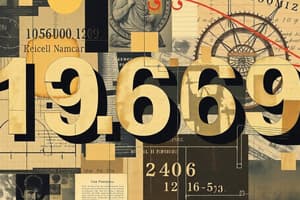Podcast
Questions and Answers
What is the purpose of rounding off in calculations?
What is the purpose of rounding off in calculations?
- To eliminate the need for compensating
- To get an exact result
- To make the calculation more complex
- To simplify calculations and estimate the result (correct)
What is the correct way to align numbers in column addition?
What is the correct way to align numbers in column addition?
- Randomly aligning the numbers
- Aligning the numbers horizontally by their place values
- Aligning the numbers diagonally by their place values
- Aligning the numbers vertically by their place values (correct)
What happens when the top digit is smaller than the bottom digit in a column during column subtraction?
What happens when the top digit is smaller than the bottom digit in a column during column subtraction?
- You add 1 to the top digit
- You borrow from the next left column (correct)
- You subtract 1 from the top digit
- You stop the subtraction process
What is the purpose of breaking down each number into its components in expanded notation?
What is the purpose of breaking down each number into its components in expanded notation?
What is the result of multiplying each digit separately in multiplication in parts?
What is the result of multiplying each digit separately in multiplication in parts?
What is the purpose of carrying over in multiplication?
What is the purpose of carrying over in multiplication?
What is the correct way to perform long division?
What is the correct way to perform long division?
What is the total error in rounding off and compensating?
What is the total error in rounding off and compensating?
When using the column addition method, what should you do when you have an extra value in a column?
When using the column addition method, what should you do when you have an extra value in a column?
What is the advantage of breaking down each number into its components in expanded notation?
What is the advantage of breaking down each number into its components in expanded notation?
What is the purpose of borrowing in column subtraction?
What is the purpose of borrowing in column subtraction?
What happens when you round a number to the nearest ten?
What happens when you round a number to the nearest ten?
What is the result of multiplying each digit separately in multiplication in parts?
What is the result of multiplying each digit separately in multiplication in parts?
Why do you need to adjust for the total error when using rounding off and compensating?
Why do you need to adjust for the total error when using rounding off and compensating?
What is the correct way to perform long division?
What is the correct way to perform long division?
What happens when you compensate for errors introduced by rounding?
What happens when you compensate for errors introduced by rounding?
What is the main difference between rounding off and compensating?
What is the main difference between rounding off and compensating?
In column addition, what happens when you have an extra value in a column?
In column addition, what happens when you have an extra value in a column?
Why is borrowing necessary in column subtraction?
Why is borrowing necessary in column subtraction?
What is the advantage of using expanded notation in addition?
What is the advantage of using expanded notation in addition?
When multiplying in parts, what do you do with the last digit of the product?
When multiplying in parts, what do you do with the last digit of the product?
What is the purpose of dividing the number step-by-step in long division?
What is the purpose of dividing the number step-by-step in long division?
What happens when you round a number to the nearest hundred?
What happens when you round a number to the nearest hundred?
Why do you need to adjust for the total error when using rounding off and compensating?
Why do you need to adjust for the total error when using rounding off and compensating?
What is the main benefit of using the expanded notation in addition?
What is the main benefit of using the expanded notation in addition?
When subtracting numbers in columns, what should you do if the digit in the top number is smaller than the digit in the bottom number in a column?
When subtracting numbers in columns, what should you do if the digit in the top number is smaller than the digit in the bottom number in a column?
What is the purpose of carrying over in multiplication in parts?
What is the purpose of carrying over in multiplication in parts?
When using the column subtraction method, what happens when you borrow from the next left column?
When using the column subtraction method, what happens when you borrow from the next left column?
What is the primary advantage of using the column addition method?
What is the primary advantage of using the column addition method?
When using the multiplication in parts method, what should you do with the last digit of the product?
When using the multiplication in parts method, what should you do with the last digit of the product?
What is the main difference between the column addition and column subtraction methods?
What is the main difference between the column addition and column subtraction methods?
What is the purpose of dividing the number step-by-step in long division?
What is the purpose of dividing the number step-by-step in long division?
Flashcards are hidden until you start studying




